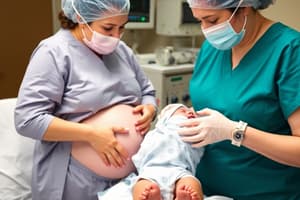Podcast
Questions and Answers
What is the primary reason for assisting a client to empty her bladder after giving birth?
What is the primary reason for assisting a client to empty her bladder after giving birth?
- To prevent uterine atony and excessive lochia (correct)
- To promote immediate postpartum pain relief
- To enhance uterine contraction
- To facilitate maternal bonding with the newborn
Which of the following is a sign of magnesium sulfate toxicity?
Which of the following is a sign of magnesium sulfate toxicity?
- Heightened deep-tendon reflexes
- Increased muscle tone
- Heart rate greater than 100/min
- Respiratory rate of less than or equal to 12/min (correct)
What is the expected descent of a client's fundus after giving birth?
What is the expected descent of a client's fundus after giving birth?
- Descend 1 to 2 cm every 24 hours (correct)
- Descend 3 to 4 cm every 24 hours
- Remain constant for 48 hours
- Rise to 2 cm above the umbilicus after 1 hour
Which action should be taken to manage variable decelerations during labor?
Which action should be taken to manage variable decelerations during labor?
What is a common sign of septic shock in a newborn?
What is a common sign of septic shock in a newborn?
What is the purpose of adding vitamin C to iron supplementation?
What is the purpose of adding vitamin C to iron supplementation?
What are the typical hemoglobin levels in clients with sickle cell anemia?
What are the typical hemoglobin levels in clients with sickle cell anemia?
Which symptom is NOT associated with Neonatal Abstinence Syndrome?
Which symptom is NOT associated with Neonatal Abstinence Syndrome?
What condition is characterized by a firm and board-like uterus and very painful symptoms?
What condition is characterized by a firm and board-like uterus and very painful symptoms?
What does the presence of ketonuria indicate in patients with Hyperemesis Gravidarum?
What does the presence of ketonuria indicate in patients with Hyperemesis Gravidarum?
Which reflex is present at birth and expected to be absent by 6 months of age?
Which reflex is present at birth and expected to be absent by 6 months of age?
What is a potential adverse effect of administering Meperidine Hydrochloride?
What is a potential adverse effect of administering Meperidine Hydrochloride?
What should be done to prepare a newborn's heel for a blood draw?
What should be done to prepare a newborn's heel for a blood draw?
What is the purpose of a tocolytic during External Cephalic Version?
What is the purpose of a tocolytic during External Cephalic Version?
What is the typical heart rate range for a newborn?
What is the typical heart rate range for a newborn?
Which of the following statements about Meperidine is true?
Which of the following statements about Meperidine is true?
Which practice should a client avoid to suppress lactation after bottle feeding?
Which practice should a client avoid to suppress lactation after bottle feeding?
What is indicated by the passage of a mucus plug tinged with blood during labor?
What is indicated by the passage of a mucus plug tinged with blood during labor?
Which of the following is a common sign of mastitis?
Which of the following is a common sign of mastitis?
What is a function of the corpus luteum during pregnancy?
What is a function of the corpus luteum during pregnancy?
What is the expected range for a newborn's blood pressure?
What is the expected range for a newborn's blood pressure?
What should be done every 2 to 3 hours during phototherapy for a newborn?
What should be done every 2 to 3 hours during phototherapy for a newborn?
Which medication is known to help promote uterine contractions?
Which medication is known to help promote uterine contractions?
Flashcards
External Cephalic Version
External Cephalic Version
A procedure where a provider manually turns a baby from a breech or transverse position to a head-down position.
Internal Cephalic Version
Internal Cephalic Version
A procedure during labor where a provider inserts their hand into the uterus to manually rotate the baby.
Graafian Follicle
Graafian Follicle
The mature ovum is released from this structure within the ovary.
Blastocyst
Blastocyst
Signup and view all the flashcards
Corpus Luteum
Corpus Luteum
Signup and view all the flashcards
Methylergonovine
Methylergonovine
Signup and view all the flashcards
Mastitis
Mastitis
Signup and view all the flashcards
Magnesium Sulfate
Magnesium Sulfate
Signup and view all the flashcards
True Labor
True Labor
Signup and view all the flashcards
Fundus Deviation
Fundus Deviation
Signup and view all the flashcards
Uterine Atony
Uterine Atony
Signup and view all the flashcards
Early Deceleration
Early Deceleration
Signup and view all the flashcards
Variable Deceleration
Variable Deceleration
Signup and view all the flashcards
Late Deceleration
Late Deceleration
Signup and view all the flashcards
Premature Newborn
Premature Newborn
Signup and view all the flashcards
Hyperemesis Gravidarum
Hyperemesis Gravidarum
Signup and view all the flashcards
Moro Reflex
Moro Reflex
Signup and view all the flashcards
Placenta Previa
Placenta Previa
Signup and view all the flashcards
Abruptio Placenta
Abruptio Placenta
Signup and view all the flashcards
McRoberts Maneuver
McRoberts Maneuver
Signup and view all the flashcards
Neonatal Abstinence Syndrome
Neonatal Abstinence Syndrome
Signup and view all the flashcards
Heel Stick on Newborn
Heel Stick on Newborn
Signup and view all the flashcards
Ketonuria during Hyperemesis Gravidarum
Ketonuria during Hyperemesis Gravidarum
Signup and view all the flashcards
Study Notes
External Cephalic Version
- Provider uses hands on mother's abdomen to turn baby from breech or transverse to head-down position
- Typically performed around 37 weeks gestation
- Often, a tocolytic is given to relax the uterus before the procedure
Internal Cephalic Version
- Provider inserts hand into uterus through cervix to manually turn baby
- Usually performed during labor
Graafian Follicle
- Expels mature ovum during embryonic development, often shortly after fertilization
Corpus Luteum
- Structure within ovary producing progesterone to maintain pregnancy
Newborn Vital Signs
- Respiratory rate (RR): 30-60 breaths/minute, with occasional periods of apnea (less than 15 seconds)
- Heart rate (HR): 110-160 beats per minute
- Blood pressure (BP): 60-80 mmHg systolic / 40-50 mmHg diastolic
- Temperature: 36.5°C to 37.5°C (97.7°F to 99.5°F)
Phototherapy for Newborns
- Monitor stool output
- Reposition newborn every 2-3 hours
- Dress newborn in only a diaper
- Cover eyes with an eye shield
- Monitor temperature regularly
- Advise parents not to apply lotion
Meperidine
- Opioid medication
- Should not be given to clients expected to deliver within 4 hours
- Crosses placenta, causing respiratory depression in newborn, peaking 2-3 hours after administration
- Narcan is ineffective at reversing respiratory depression from this medication
- Maternally, it can cause tachycardia, nausea, vomiting, dizziness, and mental status changes.
Lactation Suppression
- Clients should wear supportive bra continuously for 3 days postpartum to suppress lactation
- Avoid touching or massaging breasts
- Avoid warming breast milk
- Apply ice packs to breasts (15 minutes on, 45 minutes off) to reduce swelling
True Labor
- Contractions typically felt in lower back, radiating to lower abdomen
- Passage of mucus plug (bloody show), cervical dilatation, and effacement (thinning of cervix)
Decelerations
- Early decelerations occur due to head compression
- Variable decelerations caused by umbilical compression
Premature Newborns
- Abundant lanugo, especially on back
- Hypotonia and relaxed posture
- Few heel creases; and very abundant vernix caseosa (only present in premature / post-term newborns)
- Signs of magnesium sulfate toxicity: RR ≤ 12 breaths/minute, muscle weakness, and depressed deep-tendon reflexes
- Measure ocipitofrontal circumference (head circumference), length from top of head to heel, and chest circumference at nipple line to assess the size of a premature newborn
Septic Shock in Newborns
- Characterized by hypotension, tachypnea, tachycardia, and mottled or grey colored skin
Anemia in Pregnancy
- Defined by hemoglobin levels less than 10.5-11 g/dL
- Treated with iron and vitamin C supplementation
Placenta Issues
- Placenta Previa: Relaxed, soft, painless bright red bleeding
- Abruptio Placenta: Firm, board-like, painful dark red bleeding
Neonatal Abstinence Syndrome
- Results from exposure to opioids during pregnancy or labor
Methylergonovine
- Promotes uterine contractions
Mastitis
- Breast inflammation that can be infected
- Releasing baby from nipple before removal can help to prevent injury, and subsequent mastitis
- Waiting too long between feedings may cause clogging, which may lead to an increase in the likelihood of mastitis
Hyperemesis Gravidarum
- Severe nausea and vomiting during pregnancy, due to not consuming enough nutrients and/or due to the body breaking down fat as its primary fuel source
- Results in ketonuria
Moro Reflex
- “C” formation of thumb and forefinger and extension of legs, present at birth and gone by 6 months.
Heel Stick
- Warm the heel of the newborn with a warm washcloth prior to performing heel stick
McRoberts Maneuver
- Client's knees are pulled apart, which rotates the pubic bone, and is useful in the relief of shoulder dystocia
- Anterior shoulder can be released from the pelvis without applying pressure.
Studying That Suits You
Use AI to generate personalized quizzes and flashcards to suit your learning preferences.




